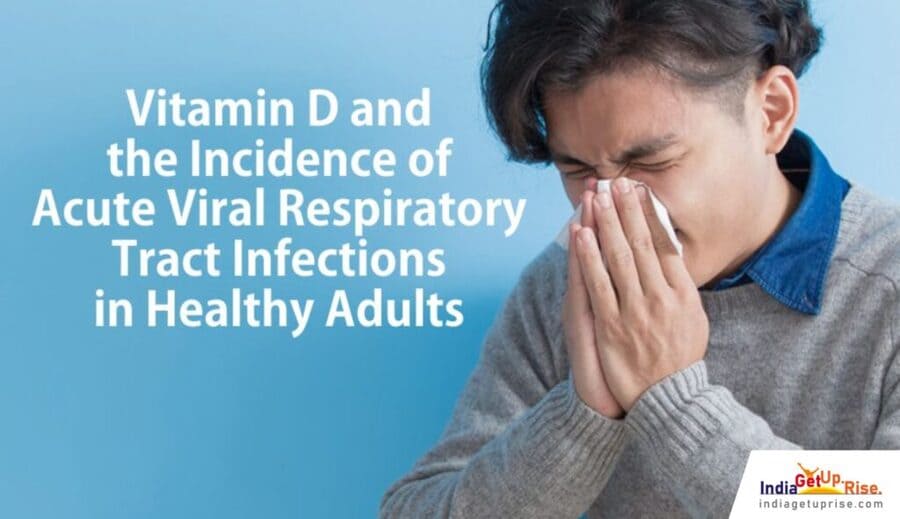Our body converts vitamin D to a chemical known as 25-hydroxyvitamin D, also called Calcidiol. Declining serum concentrations of 25-hydroxyvitamin D seen in fall and winter as distance increases from the equator may be a factor in the seasonal increased prevalence of influenza and other viral infections. This study was done to determine if serum 25-hydroxyvitamin D concentrations correlate with the incidence of acute viral respiratory tract infections.
There are seasonal variations in the incidences of viral respiratory tract infections, such as those caused by influenza, respiratory syncytial virus, and rhinovirus. Explanations for the seasonality of infections have considered the effects of environmental factors on the survival and transmission of the pathogens as well as on the behaviour and susceptibility of the hosts.
Indoor crowding is commonly thought to contribute to the influenza epidemics seen each winter in temperate zones. However, influenza epidemics do not occur in the summer in crowded workplaces or other gatherings, despite the presence of the virus and a multitude of non-immune persons. Moreover, influenza epidemics occur simultaneously at the same latitudes across the globe; this was the case even in times when transportation methods did not allow contact between persons over many degrees of longitude over a period of a few weeks. There are well-documented seasonal variations in 25-hydroxyvitamin D (vitamin D) concentrations and documented correlations between those concentrations and latitudes of residence.
Vitamin D has known effects on the immune system. The production of the antimicrobial peptides by macrophages and β-defensin by endothelial cells is up-regulated by vitamin D. These peptides may be involved in the direct inactivation of viruses. Vitamin D may modulate the production of cytokines, suppressing inflammation, and, thereby, reduce the severity of viral pneumonia.
The association between vitamin D deficiency and susceptibility to infections of the respiratory tract has been suggested for many years but has not been definitively proven. Children with nutritional rickets developed rachitic lung due to infections of the respiratory tract. Cod liver oil, rich in vitamin D, was used to treat tuberculosis. Epidemiologic studies have suggested a correlation between vitamin D concentrations and the incidence of respiratory infections, including influenza.
There have been no prospective, observational studies following adult women and men with known vitamin D concentrations for the development of acute viral respiratory tract infections. Since it is unknown if an acute infection could transiently alter the 25-hydroxyvitamin D concentration and concentrations would be expected to decline over the fall and winter as latitude increases from the equator, serial serum concentrations would have to be obtained in a prospective study done in a temperate zone.
This study was undertaken to determine if there is any correlation between the incidence of acute viral respiratory tract infections and serum vitamin D concentrations as measured monthly from September 20, 2009 to January 10, 2010 in healthy adults living and/or working in or near Greenwich, CT, USA (latitude 41.038N, longitude 73.614W). Antimicrobials administered were recorded in the case report forms.
Between each monthly visit for 25-hydroxyvitamin D determinations, all of the participants were reminded every 10 days to report any illness. At each visit after the first, a clinical assessment was made by both of the Infectious Diseases investigators to determine if an illness being retrospectively reported by a participant appeared to have been an acute viral respiratory tract infection. In that case, an illness diary was completed, but no virology studies performed. At each monthly visit records were made for each participant regarding medications, herbals, supplements, vitamins, receipt of seasonal and/or 2009 H1N1 vaccine. At the first visit, the skin pigmentation of each participant was determined to be light (white-yellow), intermediate (tan-light brown), or dark (brown-black); and, the following were recorded: age, sex, height, weight, occupation, and contact information. All data was entered into a secure web-accessible on-line database (MARVI) as well as into paper case report forms for back-up and quality verification purposes.
In this prospective cohort study serial monthly concentrations of 25-hydroxyvitamin D were measured over the fall and winter 2009–2010 in 198 healthy adults, blinded to the nature of the substance being measured. The participants were evaluated for the development of any acute respiratory tract infections by investigators blinded to the 25-hydroxyvitamin D concentrations. The incidence of infection in participants with different concentrations of vitamin D was determined. One hundred ninety-five (98.5%) of the enrolled participants completed the study. Light skin pigmentation, lean body mass, and supplementation with vitamin D were found to correlate with higher concentrations of 25-hydroxyvitamin D. Concentrations of 38 ng/ml or more were associated with a significant two-fold reduction in the risk of developing acute respiratory tract infections and with a marked reduction in the percentages of days ill.
It can be concluded that maintenance of a 25-hydroxyvitamin D serum concentration of 38 ng/ml or higher should significantly reduce the incidence of acute viral respiratory tract infections and the burden of illness caused thereby, at least during the fall and winter in temperate zones. The findings of the present study provide direction for and call for future interventional studies examining the efficacy of vitamin D supplementation in reducing the incidence and severity of specific viral infections, including influenza, in the general population and in subpopulations with lower 25-hydroxyvitaminD concentrations, such as pregnant women, dark skinned individuals, and the obese.
Please always ensure to check with your Doctor / Healthcare / Family Physician before starting with any new medication or therapy.
For any queries, feel free to reach us on our website, Facebook, Twitter, Instagram, LinkedIn
Take the free Vitamin D Test – Click here: Vitamin D Self Examination
References
- First reference



Pingback: Understanding the Link between Vitamin D Deficiency and Fatigue
Pingback: Vitamin D: The Essential Nutrient for Optimal Health